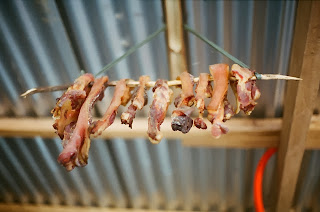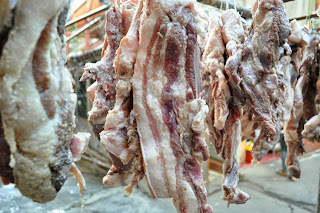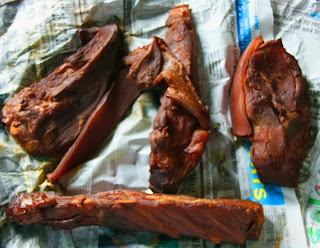Ingredients and Materials
1. 1 kl of pork, sliced into 1-inch thick slabs, it should have no bones, and must have 20% to 80% fat per slab
2. 1/5 to 1/4 kl of salt
3. a large bowl
4. Gusi (earthen jar) or any container enough for the meat
5. a stick or straw, use to pierce the slabs for hanging
6. firewoods (optional)
Procedures
1. Treating it with salt. The morning is the best time to start, particularly during summer, spring or any day that do not rain, however, there is still a way to make etag during rainy season which is the smoking procedure. So, place the meat into the bowl, press or squeeze it lightly and then pour out the extracted liquid from the bottom of the bowl, if there is any. Take out one slice and rub salt on its surface, be sure to salt inside the fissures before you return it back to the container. Do the same with the other slabs. When done, close the container airtight and set it aside for 24 hours. Do not refrigerate it.
2. After 24 hours and on… As I’ve said, it is better to start working on it in the morning so that after 24 hours, it would be another good morning (in a place with 24 hour day-night cycle) for you , perfect for the sun-soaking.After 24 hours, the procedure splits into three methods: a. sun-soaking, b. smoking, and c. is the combination of a & b.
a. Sun-soaking: Find a good place where you can soak the slabs in the sun. The Cordillerans pierced the slabs at the ends with stick (it looks like hanged laundries side by side) or with straw and hang them at a high place where carnivorous land animals could not reach. The others just put them on a clean flat surface, and they just turn the slabs regularly to sun-dry all the sides.
When the sun sets, put them back inside the container. Do not get them wet, it will hinder the curing process. If there ain’t been any interruption (i.e rain) then you can do this in three days, else you have to add more time of curing under the sun to complete the 3-day sun-soaking.
b. Smoking: The outcome of this would be a brother to the smoked meat, but etag is too salty which made it a good salting agent for other food preparations. To start with it, find a safe and shaded place where you can create just a small fire using the firewoods (be sure you woun’t be violating the fire code of your country or location). You should avoid using the resinous kind of wood like the pine tree because it would stick wicked soot on the meat and embitter your food. After creating a fire (small smoky fire), place or hang the slabs above the fire. Remember that your objective is only to smoke and not to roast or burn the meat, so you may place the meat where it could be reached by the smoke but couldn’t be reached by the radiant heat. Do this for 30 minutes everyday for 1 week. Put back the slabs into the container after each session.
c. Combination: This is just doing both methods a the same time. Just choose a place where a wind couldn’t distract the smoking procedure. Smoke them for 1 hour while they’re being soaked in the sun, or you may do it your own way as long as they get smoked and sun-dried. Who knows, you can actually create the best etag in the world. Do these everyday for 3 days.

3. Keeping or storing the etag. After the days of curing, the etags are ready to be consumed. But if you want to store them for future consumption then it’s fine, you have made them to be preserved for a long long time. I’ve heard that the oldest etag that ever eaten was five years old (ahrgkk!), but the old folks said that etag after 6 months and up should not be eaten and to be discarded.
4. How to consume etag. Of course, you make etag for your immediate consumption. The simpliest way to consume it is by eating it plainly. Wash it to lessen its saltiness, then cook it in any way you like, then eat it with rice. As an ingredient, these can be added to many kind of dishes ranging from pinikpikan to chopsuey. The Highlanders chop them into small pieces and add them to their vegetable saute.







